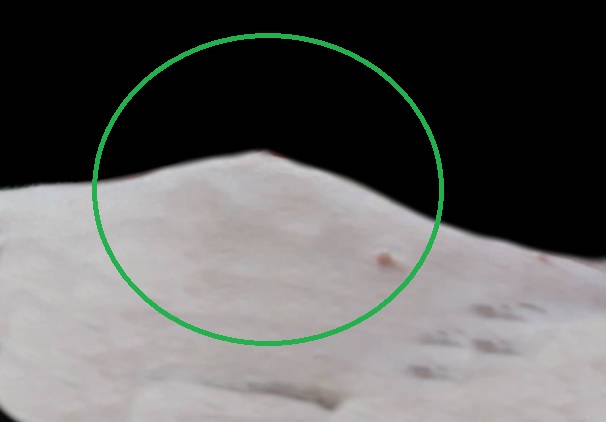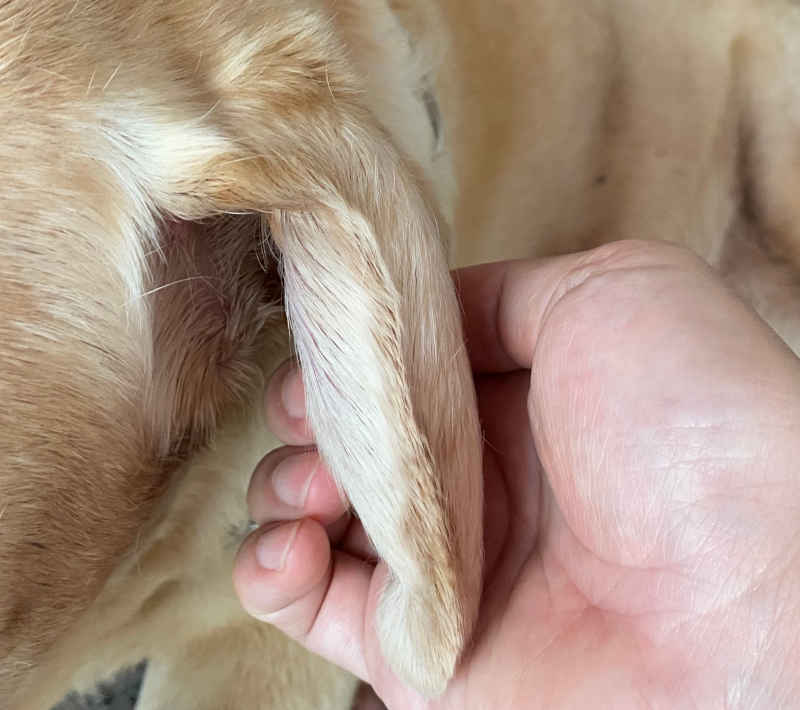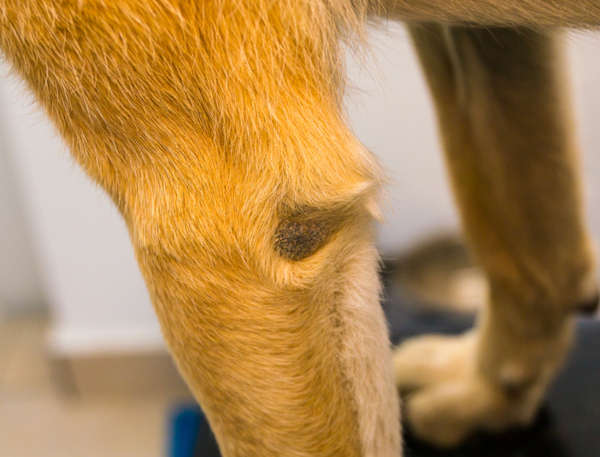
This article was updated on August 14th, 2023
Finding a fluid filled lump on your dog will be a worrying time, and you’ll want to know what is going on as soon as possible. Owners should keep in mind that there are a huge range of things that could be going on, most of which are benign and easily treated. As a vet, I encounter lumps like this several times a week and the vast majority require no therapy or resolve quickly.
For some dogs, the lump will be a subcutaneous fluid lump (under the skin), but these lumps can also be visible over the skin. Any new lump that feels fluid filled should be looked into by a vet promptly so we can get a better understanding of what is going on.
Signs that a fluid or blood-filled lump needs veterinary attention
Let’s take a look at some of the ‘red flags’ when it comes to fluid-filled lumps and bumps on our pets:
- A lesion that is causing your dog discomfort. This may mean that they lick or chew the area, or that they are limping, lethargic or off their food.
- A lump that is quickly growing.
- A growth that ruptures and starts to bleed or ooze pus or other liquid, such as serous fluid.
- A blood filled-lump (or blister) that forms on the ear and is associated with an ear infection.
- A swelling that occurs in the few days after a surgery.
Keep in mind that any new fluid-filled lump is abnormal and is something we should have assessed by the vet.
Most frequent bumps or lumps filled with fluid or blood
1. Cyst
A cyst is an incredibly common lesion found on a dog and they can appear anywhere on the body. A small, fluid lump found on the dog’s chest, back or flank will often be a cyst. As well as being fluid-filled, some cysts will contain harder or ‘cheesy’ type material. Most cysts are caused by blocked ducts or hair follicles.


A cyst will usually be round, symmetrical and smooth. They don’t bother the dog and most dogs are unaware that they have a cyst.

Vets often pop a needle inside cysts, in order to determine what type of fluid is inside them. In some instances, the fluid will flow freely, meaning the cyst can be completely drained. Cysts are not always easily diagnosed and if the vet is unsure if the growth is a cyst, they may sample the contents and send them to the lab for diagnosis.
Typically, after a cyst has been drained, it will soon refill. If we want to remove the cyst permanently, a surgical procedure to take out the cyst wall is required. The prognosis for canine cysts is excellent. Learn more about the different types of cysts in dogs.
2. Seroma
A seroma is a build-up of serous fluid under the skin in the dog, and it often occurs after a surgical procedure. This is especially true when a large lump was removed and a lot of ‘dead space’ was left behind. We also see them in big males after castration, when the scrotal sac fills with fluid. Any patient can develop a seroma, but those who are large and active tend to be affected more commonly.
While some assume a seroma should be drained, this is usually not needed and can introduce infection. Rather, we tend to allow the body to absorb the fluid, and don’t intervene. In some instances, when a seroma is very big, we may apply a temporary pressure bandage.
We need to watch closely for signs of infection (such as red skin or a bad smell), as infected seromas would require draining and a course of antibiotics. Uncomplicated seromas are usually gone completely within a few weeks.

In the above image, this female has developed a seroma after her spay surgery.
3. Ear flap hematoma
A blood-filled lump on a dog’s ear flap is generally going to be an aural hematoma. These are incredibly common and often occur in those with chronic ear infections who have been shaking their heads excessively, leading to blood vessels within the ear flap rupturing.
In the picture below, we can see that the skin inside the ear is thickened and irregular, which indicates a chronic infection. There is a fluid filled ‘balloon’ at the base, which is the hematoma.

The skin above a hematoma may be red and warm and dogs are often tender when touched on their ear flaps. As many dogs have concurrent ear infections, they tend to be especially head shy and may not be keen for you to look at their ear.

Aural hematomas are treated by draining all of the blood with a needle. Many vets will then inject steroids locally, which is thought to prevent the blood from re-filling. When the haematoma does recur, dogs may require a surgical procedure such as a ‘tacking’ of the ear cartilage together, so that blood can no longer enter the area. Learn more about ear hematomas in dogs with pictures and vet advice.
4. Abscess
An abscess is an infected, pus-filled lump that forms under the skin and causes can include bites from other animals, insect stings or foreign bodies under the skin (such as grass awns or shards of glass).
Some abscesses will be blood-filled, but others will consist of yellow or green build up (which is the pus). Initially the lump will be under the skin but after a few days it may rupture onto the surface and we will see (and smell!) the fluid contents. At this point, the dog often feels quite a bit of relief. The skin around the abscess tends to be red and inflamed.

Abscesses should be drained, which can require sedation when they are large fluid-dilled lumps. The vet will flush the area with salt water and start the patient on some antibiotics and anti-inflammatories. If there is a foreign body under the skin, it would need to be removed to ensure the abscess does not re-form.
5. Hygroma
We will typically see hygromas on the bony prominences of large dogs who lie on hard surfaces like pavement or tiles. They form in an effort to protect the dog’s skeleton and to minimize friction. In the photo below, the dog has a hygroma on the elbow and the fur above it is missing; this would be quite typical. The swelling over the joint feels soft and fluid-filled and causes no pain to the dog when pressed.

A hygroma is usually diagnosed from experience, as a vet will know what they look and feel like. They occur in older, larger breeds in quite specific places (where bones/joints have the least padding). There is no need to treat hygromas but it is worth offering these dogs a thick, padded bed. Owners should also monitor the hygromas to ensure they do not become infected.
How a veterinarian will find out what your dog’s lump is
Diagnosis
For some lumps, such as hygromas, seromas and aural hematomas, a vet will generally be able to make a diagnosis from simply examining the dog. In other cases, the vet may use some diagnostic tests, such as a Fine Needle Aspirate (popping a needle into the lump to aspirate fluid) or imaging.
Less commonly, a fluid-filled lump will be biopsied, if a vet wants to ensure there is not something more sinister going on.
Cost of diagnosis
Oftentimes, the cost of diagnosing a fluid-filled lump will be as much as a routine consult: $40-60. In other instances, an owner may need to pay for sedation and/or sampling of the lesion, so we may be looking at around $300-400.
Treatments
The treatment will depend on what type of fluid-filled lump or bump we are dealing with. Lumps like cysts do not always need treatment and we often take a ‘wait and monitor’ approach with them. Similarly, for lumps like seromas, we usually let the body deal with them.
An aural hematoma is different and does require prompt treatment or home remedies with your vet’s help. This usually means draining the blood with a needle, which can be done consciously in a compliant pet. When the hematoma continues to refill, we may need to perform a procedure to temporarily ‘tack’ the ear cartilage together. This procedure is done under sedation or anesthetic and costs from $200-500. Click here for more information on ear hematomas in dogs (with pictures and vet advice).
An abscess is another fluid-filled lump that needs veterinary treatment. For smaller abscesses, antibiotics are issued at a price of $20-50. For larger abscesses, that need to be drained under sedation, the bill may come closer to $200-300.
Disclaimer: This website's content is not a substitute for veterinary care. Always consult with your veterinarian for healthcare decisions. Read More.


Be the first to comment